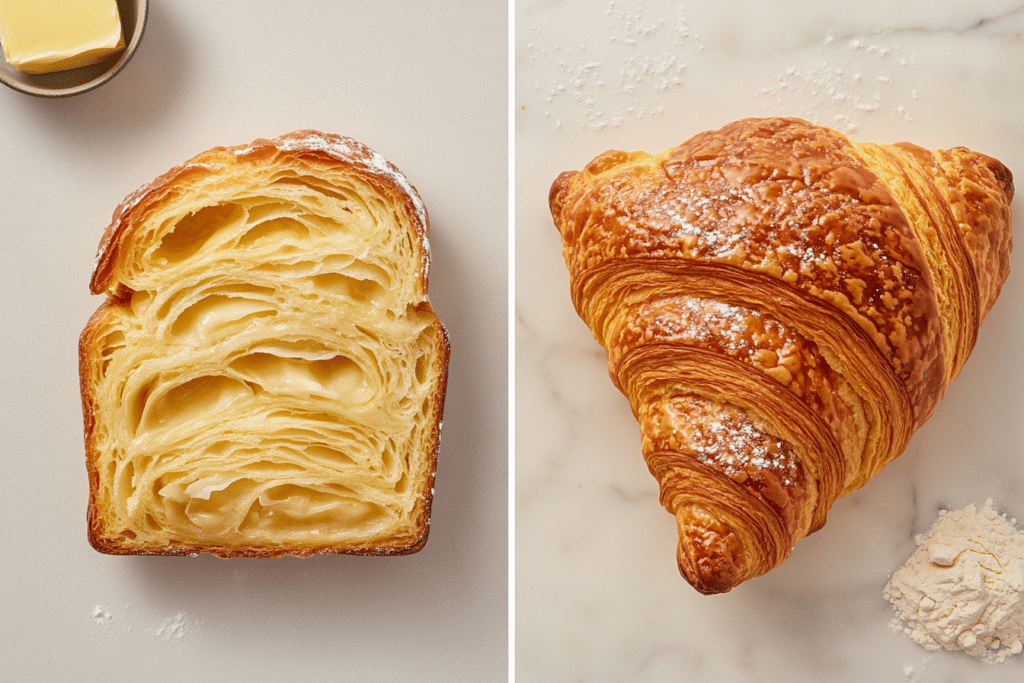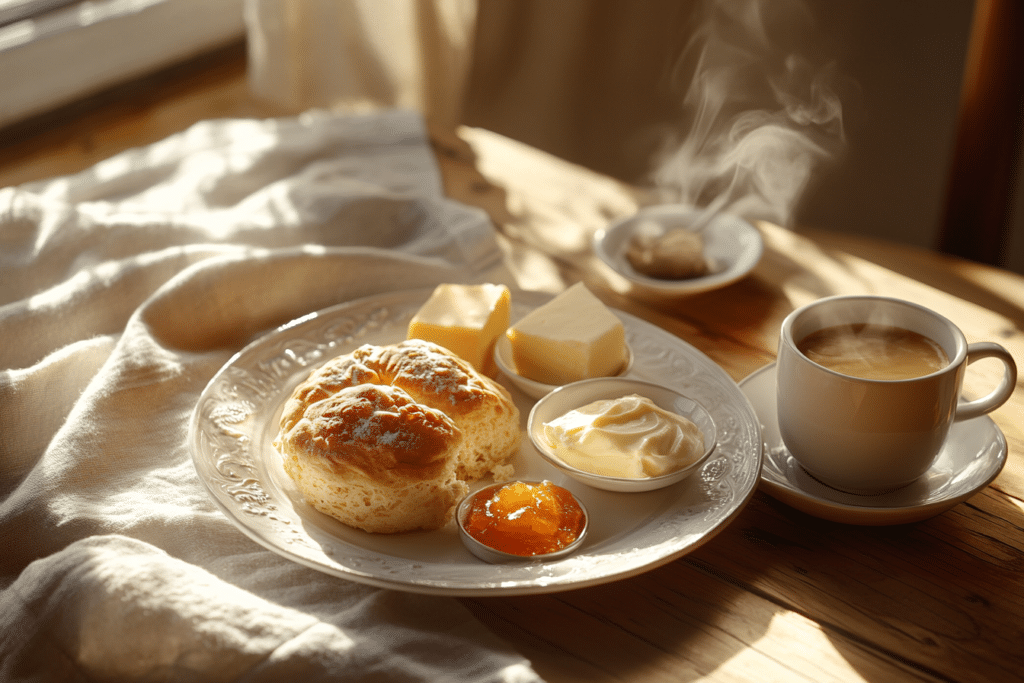1. Introduction
Croissants are loved worldwide for their buttery layers and delicate crescent shape. However, did you know that Switzerland has its own version of this classic pastry? If you’ve ever asked, “What is croissant called in Switzerland?”, the answer lies in a simple yet delicious Swiss creation: the Gipfeli.
The Gipfeli may look similar to its French counterpart, but it holds its own unique identity. From differences in texture and flavor to its role in Swiss culinary culture, the Gipfeli reflects both tradition and modern creativity. Whether enjoyed during breakfast or as a snack with coffee, this pastry has become a staple in Swiss bakeries and homes.
In this article, we will uncover what a croissant is called in Switzerland, its origins, the differences between Gipfeli and traditional croissants, and where you can find the best ones. If you’re curious about Swiss gastronomy, you’re in for a treat—read on to explore the wonderful world of Gipfeli.
2. What is a Croissant and Why is it Called Something Different in Switzerland?
Before we dive into what is croissant called in Switzerland, let’s first understand the croissant itself. This buttery, flaky pastry has earned a cherished spot in bakeries around the world, known for its delicate layers and crescent-shaped elegance.
2.1 Origins of the Croissant and Its Journey to Switzerland
The story of the croissant begins in Austria, where an early version called the “Kipferl” was enjoyed as far back as the 13th century. Shaped like a crescent moon, the Kipferl was a denser pastry compared to the airy, layered croissant we know today.
It wasn’t until the 19th century that French bakers transformed the Kipferl into the croissant by using laminated dough, a technique that involves layering butter between thin sheets of pastry dough. This innovation created the iconic flakiness and golden layers that define the modern croissant.
2.2 The Role of Croissants and Swiss Gipfeli in European Cuisine
Today, croissants are a global staple, enjoyed as part of breakfast or as a snack. The French croissant, made with high-quality butter and precise folding techniques, has become the standard worldwide.
From Paris to Tokyo, and New York to Zurich, croissants appear in countless forms, including:
- Plain Croissants: The classic version, golden and buttery.
- Chocolate Croissants (Pain au Chocolat): Filled with rich chocolate.
- Almond Croissants: Stuffed with almond paste and topped with sliced almonds.
Now that we’ve established the origin and evolution of the croissant, let’s explore what croissant is called in Switzerland and how the Swiss version stands apart.
3. What is Croissant Called in Switzerland? A Complete Guide
If you’ve ever traveled to Switzerland or visited a Swiss bakery, you might have noticed that croissants go by a different name. So, what is croissant called in Switzerland? The answer is Gipfeli.
This term is widely used across Switzerland, particularly in the German-speaking regions, where it reflects the unique blend of tradition and cultural identity. While Gipfeli resembles the French croissant in appearance, its texture, flavor, and significance within Swiss cuisine give it its own distinct charm.
3.1 Why is a Croissant Called Gipfeli in Switzerland?

In Switzerland, Gipfeli is the name given to this beloved crescent-shaped pastry. The word “Gipfeli” comes from the German word “Gipfel”, which means “peak” or “summit”—a fitting description for the pastry’s iconic shape. If you’re curious about making this Swiss specialty at home, here’s a step-by-step Gipfeli recipe for perfect Swiss pastries.
How is a Gipfeli different?
- While French croissants are known for their buttery and flaky layers, Swiss Gipfeli tend to be denser and less buttery. This makes them a slightly heartier alternative, perfect for pairing with coffee or Swiss hot chocolate.
- Swiss Gipfeli are often enjoyed plain or with a light glaze, unlike French croissants, which may have more variations like almond or chocolate fillings.
Gipfeli holds a special place in Swiss food culture, where it is a staple of breakfast and mid-morning snacks. You’ll find it in nearly every bakery and café, freshly baked each morning to delight locals and visitors alike.
3.2 How Does Gipfeli Differ From the Croissant in Switzerland?
The term “Gipfeli” highlights the linguistic influence of Switzerland’s German-speaking regions. In German, “Gipfel” means a peak or summit, and the name likely refers to the crescent shape of the pastry, resembling the peak of a mountain or hill.
This linguistic adaptation reflects the country’s rich diversity, as Switzerland is a multilingual nation with German, French, Italian, and Romansh as its official languages. While Gipfeli is the dominant name in German-speaking areas, other terms may appear in Switzerland’s other linguistic regions:
- In French-speaking Switzerland: The pastry is still commonly referred to as a croissant.
- In Italian-speaking Switzerland: It may be called cornetto, borrowing from Italian culinary traditions.
This regional variation in terminology further demonstrates Switzerland’s unique cultural identity. Whether you call it a Gipfeli, croissant, or cornetto, the pastry remains a shared delight across the country.
3.3 What is Croissant Called in Switzerland’s Other Regions?
While the name Gipfeli dominates in most Swiss bakeries, slight variations in terminology and preparation exist based on the linguistic regions:
- German-Speaking Regions (Majority of Switzerland): The name Gipfeli is used widely and applies to both plain and filled versions.
- French-Speaking Regions (Romandy): The term croissant remains the most popular, reflecting the influence of neighboring France. Bakeries here may offer croissants similar to those found in Paris.
- Italian-Speaking Regions (Ticino): The word cornetto, borrowed from Italian, is used. These versions may include almond cream, chocolate, or jam fillings, mirroring Italian preferences.
Despite the different names, the Gipfeli remains a unifying treat that brings people together over a cup of coffee or tea, no matter the region.
4. Differences Between Swiss Gipfeli and French Croissants
Although Swiss Gipfeli and French croissants share a similar crescent shape, they differ in many ways. From texture and ingredients to cultural roles, understanding these differences helps highlight what croissant is called in Switzerland and why Gipfeli stand out.
4.1 How Does the Swiss Croissant Compare in Texture?

One of the most noticeable differences between Swiss Gipfeli and French croissants lies in their texture and appearance.
- Swiss Gipfeli:
- Gipfeli tend to be denser and less flaky compared to croissants. The pastry is heartier, making it ideal for a filling breakfast or snack.
- The layers are thinner, and the dough feels sturdier, often giving it a slightly chewy texture.
- Gipfeli have a more matte surface, and some varieties are lightly glazed to add a hint of sweetness.
- French Croissants:
- Croissants are known for their airy, flaky layers created through meticulous lamination, where butter is folded into the dough multiple times.
- They have a crisp, golden-brown exterior and a delicate crumb structure inside.
- Croissants often boast a shiny, buttery finish without additional glazes.
While both pastries are visually similar, biting into a Gipfeli reveals its denser, more substantial feel, whereas a croissant crumbles into delicate flakes. Understanding subtle differences in baked goods, such as the difference between crème brûlée and custard, highlights how even small adjustments in preparation can create unique culinary results.
4.2 How Swiss Gipfeli Tastes Compared to Croissants
The taste of a Swiss Gipfeli is another key factor that distinguishes it from a French croissant.
- Swiss Gipfeli:
- Gipfeli are less buttery and have a milder flavor profile. This makes them a versatile pastry that pairs well with sweet or savory accompaniments.
- Swiss bakers use high-quality local ingredients like Swiss butter and flour, which impart a rich but subtle taste.
- French Croissants:
- Croissants are much richer and more buttery due to the higher butter-to-dough ratio. Each bite melts in your mouth, delivering a robust, buttery flavor.
- The French version is typically eaten plain or with minimal accompaniments to let the pastry’s flavor shine.
For those who prefer a lighter pastry, Gipfeli offers a perfect alternative to the decadence of traditional croissants.
4.3 Cultural Importance of Croissants in Switzerland
Another key difference between Gipfeli and croissants is their role in their respective food cultures.
- In Switzerland:
- The Gipfeli is a beloved breakfast staple, commonly enjoyed in Swiss households, cafés, and bakeries. It’s often paired with coffee, butter, jam, or even Swiss cheese.
- Swiss people appreciate Gipfeli for its simplicity and versatility—it’s just as satisfying on its own as it is with accompaniments.
- In France:
- The croissant is deeply rooted in French culture and is typically part of a traditional French breakfast (petit déjeuner), alongside coffee and orange juice.
- In French bakeries, croissants are often enjoyed plain or with minimal enhancements like a light smear of butter or jam.
While croissants symbolize French finesse and indulgence, Gipfeli reflect Swiss practicality and hearty traditions. Both pastries, however, play a similar role in bringing people together over food.
5. Why Gipfeli Plays a Key Role in Swiss Breakfast Culture
In Switzerland, Gipfeli holds a special place in the hearts of locals, especially as a breakfast favorite. While many countries enjoy croissants, the Swiss have incorporated their version—Gipfeli—into a unique culinary tradition that emphasizes simplicity, high-quality ingredients, and a cozy dining experience.
5.1 What is Croissant Called in Switzerland at Local Cafés?
In almost every Swiss town, Gipfeli is a staple found in bakeries, cafés, and supermarkets. Each morning, freshly baked Gipfeli are displayed in rows, tempting early risers with their golden-brown appearance. Unlike the French croissant, which is often reserved for leisurely breakfasts, the Swiss Gipfeli is more versatile:
- Quick Breakfast: Many Swiss people enjoy a Gipfeli on the go, grabbing one from a bakery with a cup of coffee before heading to work.
- Café Tradition: Swiss cafés serve Gipfeli alongside café crème (Swiss-style coffee with cream) or hot chocolate. It’s common to see locals enjoying a quiet morning with their pastry and drink.
The simplicity and accessibility of Gipfeli make it a breakfast option that suits a range of lifestyles, from busy professionals to families.
5.2 How Do the Swiss Serve Gipfeli for Breakfast?

Swiss breakfast culture celebrates balance and tradition, and Gipfeli is no exception. While it’s delicious on its own, the Swiss often pair it with simple accompaniments:
- Butter and Jam: A light spread of butter or jam (such as strawberry or apricot) enhances the subtle flavor of the Gipfeli.
- Swiss Cheese: For a savory twist, slices of Swiss cheese like Emmental or Gruyère complement the pastry’s texture.
- Coffee and Tea: Gipfeli is almost always enjoyed with coffee—particularly café crème—or a hot cup of tea. This pairing makes for a balanced, satisfying start to the day.
In many ways, the Gipfeli embodies the Swiss philosophy of enjoying high-quality food in moderation, without excessive embellishments.
5.3 Modern Twists: Unique Variations of Croissants in Switzerland
While traditional Gipfeli remains the most popular, Swiss bakers have embraced modern trends by offering creative variations that cater to evolving tastes. Some of the most common variations include:
- Schoggi-Gipfeli (Chocolate-Filled): Similar to the French pain au chocolat, this version features a rich chocolate filling. It’s especially popular among children and those with a sweet tooth.
- Mandel-Gipfeli (Almond): Filled with almond paste and sometimes topped with sliced almonds, this version adds a sweet and nutty twist to the classic pastry.
- Vegan Gipfeli: For those following a plant-based diet, vegan Gipfeli substitutes traditional butter with plant-based alternatives while maintaining the pastry’s signature shape.
- Whole Grain Gipfeli: Health-conscious eaters can opt for whole grain versions, which provide added fiber and a heartier flavor.
These modern variations reflect the Swiss ability to innovate while preserving culinary traditions. Today, whether you prefer a classic plain Gipfeli or a chocolate-filled treat, Swiss bakeries offer something for everyone. For another nutty Swiss pastry, you might enjoy learning about the Nussgipfel, a crescent-shaped treat with a sweet nut filling.
6. FAQs About What is Croissant Called in Switzerland?
6.1 What is the Difference Between Gipfeli and Croissant?
The key difference between Gipfeli and French croissants lies in their texture and flavor. Gipfeli are denser and less buttery, making them heartier, while croissants are known for their flaky layers and rich buttery taste.
6.2 Is Gipfeli Unique to Switzerland?
Yes, Gipfeli is unique to Switzerland. The name and slightly altered recipe distinguish it from French croissants, though they share a common origin. In German-speaking Switzerland, Gipfeli is the preferred term, while other linguistic regions use terms like croissant or cornetto.
6.3 What’s the Best Way to Eat a Gipfeli?
Gipfeli can be enjoyed plain or paired with butter, jam, or Swiss cheese. It’s commonly served with café crème or hot chocolate for a classic Swiss breakfast experience.
6.4 Can I Find Gipfeli Outside of Switzerland?
While Gipfeli are primarily a Swiss specialty, they may appear in bakeries in countries with strong Swiss communities. Some European bakeries also offer versions of Gipfeli, though they may differ slightly in flavor and preparation.
6.5 How Do You Pronounce Gipfeli?
Gipfeli is pronounced “GIP-fuh-lee”. The name comes from the German word Gipfel, which means “peak” or “summit,” referring to the pastry’s crescent shape.
7. Conclusion
So, what is croissant called in Switzerland? It’s the beloved Gipfeli, a staple of Swiss breakfast culture. While it shares its origins with the French croissant, the Swiss Gipfeli has carved out its own identity with its denser texture and subtle flavor.
From bustling bakeries to cozy cafés, Gipfeli remains an essential part of daily life in Switzerland. Whether you enjoy it plain, with butter and jam, or in its modern variations like almond or chocolate-filled, the Gipfeli reflects the Swiss love for quality, tradition, and simplicity.
Next time you’re in Switzerland, don’t miss the chance to savor a freshly baked Gipfeli alongside a warm cup of café crème. It’s a delicious experience that captures the heart of Swiss culinary tradition.
